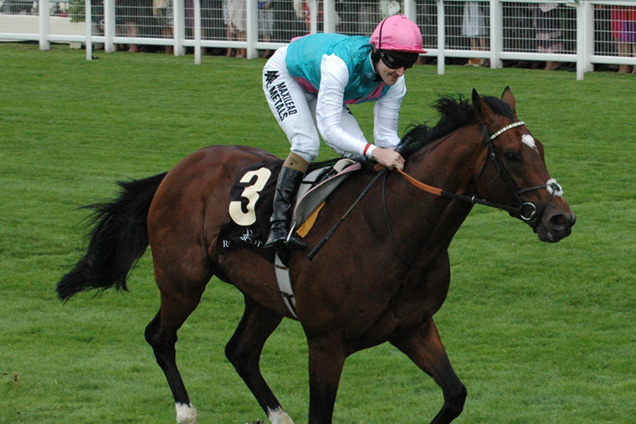3 minute read
There are five Group 1 races at Royal Ascot over a mile or further. Nic Doggett scours the Racehorses annuals for the best performance in each race this decade.

Coronation Stakes
2007 – Indian Ink 122The timing of the Coronation Stakes at Royal Ascot is ideal for attracting fillies who have made a mark in the European classics over a mile. Four Guineas winners were put firmly in their place by Indian Ink, who triumphed by six lengths. The winning margin was one of the widest in the history of the race, and the biggest since it was elevated to Group 1 status in 1988. It was consequently regrettable that the winner did not make another public appearance until the December Sales at Newmarket, where she was sold to Sheikh Hamdan's Shadwell Estate Company for 2,000,000 guineas and promptly retired to stud. Not a bad profit on a filly who had fetched only 25,000 guineas at the same venue as a yearling.
2008 - Lush Lashes 122In what was, by modern standards, a strenuous campaign, Lush Lashes proved herself one of the very best of her sex at a mile, a mile and a quarter and a mile and a half, moving up and down in distance. The Coronation Stakes was chosen in preference to the Ribblesdale Stakes because of its higher status, but did not have a single Group 1 winner among its eleven runners, though 33/1-shot Love of Dubai had notched a classic victory in the Premio Regina Elena. Lush Lashes, the second favourite, raced prominently behind the pace set by Nahoodh, quickened to lead inside the last two furlongs and readily held the challenge of Infallible before drawing away in the final hundred yards to win by three and a quarter lengths.
Gold Cup2008 Yeats 126+
There were various pieces of good news through the year, as well as the usual cluster of bad, but one of the best came early in November. Aidan O'Brien confirmed to the racing media that Yeats would be staying in training to try to win a fourth successive Gold Cup at Royal Ascot, a feat never achieved in the race's two hundred and one year history. Yeats started 11/8 favourite in the Gold Cup, reopposed by the second, third and fourth from the previous year, and in the race itself moved through to lead with half a mile left. Coastal Path had a crack at him but was floundering with two furlongs to go, when a more serious threat emerged in the shape of Geordieland, whose smooth run actually took him narrowly to the front over a furlong out. For a very brief moment, Yeats looked to be staring at defeat, but he knuckled down under pressure and in the final hundred yards drew away for a five-length success. As Yeats was challenged by Geordieland, the Royal Ascot stands erupted and the response when Yeats returned to the unsaddling enclosure was no less resounding. A number of performances during the season were superior to that of Yeats in the Gold Cup, but in many respects this was the race of the year.St James’s Palace Stakes
2002 Rock of Gibraltar 129+Rock of Gibraltar faced anything but a straightforward task on form, though he started at 5/4-on. He was up against his very smart stablemate Landseer and the Andre Fabre-trained Bowman, a fast finishing third to Landseer in the Poule d'Essai des Poulains. Bowman was sent off second favourite at 4/1 in a field of nine for the St James's Palace which also included Dupont, who had landed the Guineas double in Italy and Germany, and three who had finished behind Rock of Gibraltar at Newmarket. The patiently-ridden Rock of Gibraltar gave arguably his best performance, producing an excellent turn of foot to sweep aside Landseer entering the final furlong, winning largely under hands and heels by a length and three quarters, the first two pulling clear. It goes almost without saying that the hardy Timeform epithet `tough, genuine and consistent' fits Rock of Gibraltar to a T, though he didn’t have to show his true mettle here, displaying his class instead.
Prince of Wales’s Stakes2000 Dubai Millennium 137+
At Royal Ascot 2000, the upgrading of the Prince of Wales's Stakes to Group 1 status was rewarded spectacularly when both Dubai Millennium and Sendawar were declared as runners. With Frankie Dettori unable to take the mount following his plane crash earlier in the month, Dubai Millennium was ridden by leading US jockey Jerry Bailey. Though the jockey was different, the result was the same - another spectacular display of front-running. After something of a phoney war through the first furlong, Dubai Millennium was warmed up and Bailey let him loose. Cracking on at a furious pace, they rapidly had the field well strung out with Gerald Mosse on Sendawar the only jockey who attempted to stay in close touch at this stage. While Bailey sat still and pointed Dubai Millennium in the right direction, Sendawar was clearly straining to keep up, and fighting a losing battle, from a long way out. The margins entering the straight were Dubai Millennium ahead of Sendawar by four lengths and Sendawar ahead of the rest by five. Bailey first gathered up the reins and began pushing just inside the two-furlong marker, at which point Sendawar was backpedalling and Dubai Millennium was left to complete on his own. After the race, Bailey explained: `Frankie and Sheikh Mohammed talked to me and said the best thing was not to get in his mouth, let him have his head, he will relax better that way.' It worked.Queen Anne Stakes
2012 Frankel 147After taking the breath away (again) with a five length win in the Lockinge, Frankel's next race was in the Queen Anne Stakes, where he met some familiar rivals and was sent off at 10/1-on against ten opponents, only two of whom had also been successful in Group 1 company, Excelebration and the Caulfield Guineas winner Helmet who was having his first start in Britain since being imported from Australia. Frankel delivered the perfect answer to those clamouring for something new. Instead of beating Excelebration by four and five lengths, he beat him by eleven! Always travelling strongly, Frankel went past Bullet Train with less than three furlongs to go, Excelebration staying in touch with him at first before Tom Queally unleashed Frankel, who burst clear from the two-furlong pole and galloped on remorselessly. Excelebration was four or five lengths in front of the rest until he faltered inside the final furlong, almost certainly paying the penalty for trying to keep up with Frankel and eventually holding on for second by just a neck from Side Glance. Frankel's trainer Sir Henry Cecil was the centre of attention after the Queen Anne. 'I wanted Tom to produce him between the two-and-a-half marker and the two-furlong pole, because he's got a good stride on him and takes some catching, keeping going when other horses don't . . . he's a great horse, he's exceptional.’ No horse in Timeform's sixty-five-year experience would have beaten him that day. There are nine official Flat categories used for describing horses here at Timeform, from ‘poor’ to ‘top class’. Sitting above all of those, in a bracket of his own, is one labelled ‘Frankel’.






